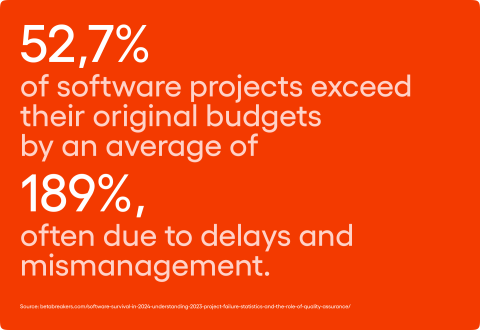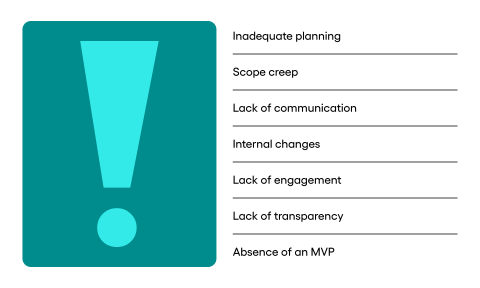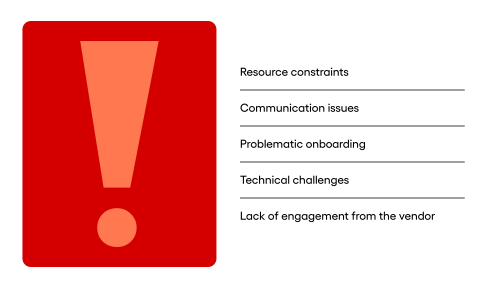Top strategies to overcome IT project delays and stay on track


Seven out of ten IT projects fail to finish on time, according to Forbes, which cites a report from Haystack. Naturally, more time spent working means much higher costs. A Betabreakers report reveals that 52.7 percent of IT projects exceed their budgets by 189 percent. Clearly, this is a serious issue, and when we look closer, it turns out to be a complicated one with many layers. That’s why this blog post exists — to examine the perspectives of both the client and the IT company separately, while also considering what early signs might warn us of delays lurking ahead, even if we don’t yet realise it.
Table of contents
The consequences of IT project delays
Delays in projects bring a host of negative effects. The most obvious one is the rising cost. Another is the damage done to the relationship between the client and the company delivering the work, as missed deadlines can weaken trust and make future teamwork harder.
Beyond that, a late launch might ruin our chances in the market, reducing our competitiveness — or, in extreme cases, wiping it out completely.
What about the team, though? When deadlines aren’t met, it harms their morale, which could lead to more staff leaving. This, in turn, worsens the project’s troubles. On top of that, delays disrupt the company’s long-term plans and strategies. As you can see, the chain of painful consequences stretches far.

Challenges on the client’s side
Now, let’s explore the project management challenges that come from the client’s actions — whether intentional or not — and how these can cause delays.
1. Poor planning
Unrealistic deadlines and vague goals are just some of the issues that plague IT projects. If there’s no thorough analysis of needs, resources, or possible risks, the result is flawed assumptions that inevitably lead to setbacks.
Many people also complain that key decision-makers aren’t involved enough in planning, which slows down decisions. For instance, a company rushes to roll out a new internal system without fully checking how it fits with their current setup. They then hit unexpected problems, like compatibility headaches, untrained staff, or the need to tweak outdated systems — leading to months of delays and a increasing budget.
How can this be avoided? The answer lies in taking time to plan properly. Carrying out a risk assessment, setting sensible deadlines, and bringing in experts early are essential steps. It’s also vital to define goals clearly and ensure all stakeholders agree on priorities before the project begins. Having a backup plan, one that allows a calm and organised response to surprises, is worth considering too.
2. Scope Creep
When a project’s requirements keep growing beyond the original agreement, delays become unavoidable for obvious reasons. This often happens because the project’s scope isn’t clearly defined at the start, or because the process for managing changes isn’t strong enough.
Clients, noticing progress, sometimes add new features or demands without fully understanding how these affect the timeline and budget.
Take a team building a CRM system, for example. Mid-project, the client requests advanced reporting, links to external systems, and a customised interface. Each addition demands extra time, resources, and testing, stretching the schedule and inflating costs considerably.
To prevent this, set a clear scope from the beginning — especially if billing is based on time and materials — and agree on firm boundaries. A formal change management process is vital too, so new requests can be reviewed and either scheduled for a later phase or assigned extra time and budget.
Regular chats with the client about how changes impact the project, along with negotiating adjustments to the timeline or costs, help keep things on track.

3. Lack of communication
Poor communication causes misunderstandings, duplicated efforts, mistakes, and delays. This often stems from undefined communication channels, unclear responsibility for sharing updates, or a reluctance — or inability — to exchange knowledge freely.
For instance, a client mentions wanting to add a payment system integration midway through a project. Without clear API details, the developers start work with incomplete information, only to face major rework later, pushing the project back by weeks.
The solution? Hire a Project Manager to take charge of meeting goals, including picking the right communication tools. They’ll ensure regular meetings happen, establish clear channels, and handle information flow, keeping everyone aligned and informed.
4. Internal changes
Shifts in a company’s priorities, financial troubles, restructuring, mergers, or takeovers can throw a project off course. While undergoing such changes, a client might struggle to make decisions, provide resources, or meet deadlines, often due to shifting business conditions.
Imagine a firm in sudden restructuring: decision-making stalls, halting the contractor’s progress. Budget cuts then force a scope rethink, leading to delays and contract renegotiations.
To guard against this, build a budget buffer during planning. Staying in constant touch with stakeholders also helps spot and adapt to priority shifts early. Adding contract clauses that allow timeline and budget tweaks for unexpected events is a smart move too.
5. Low engagement
When a client isn’t involved enough, it slows the project’s pace, delaying decisions and document approvals.
Picture a client who’s consistently late with key choices or data, forcing the contractor to pause work and reshuffle timelines. Their absence during testing and handover means the final product doesn’t match expectations, triggering last-minute fixes.
To tackle this, set clear expectations with the client at the outset — define their role and agree on approval deadlines. Regular updates on progress, asking for feedback, and involving them in decisions keep them engaged. Building a relationship based on trust and mutual understanding is the foundation for success.
6. Lack of transparency
Transparency matters hugely in any project, and it’s a two-way street. If a client hides worries, internal conflicts, or problems from the contractor, it can make delivering the project tougher. Without the full picture, the contractor might make poor decisions.
For example, a client keeps quiet about financial troubles that later limit project funding. Unaware of the risk, the contractor ploughs ahead with the original plan — only for the client’s cash issues to surface, delaying everything and straining their relationship.
How to tackle this? Open communication is essential. The client should share anything that might affect the project, so both sides can tweak the scope or funding together if needed.
7. Skipping the MVP
Some clients insist on building a fully loaded product right away, rather than starting with a basic, working version that users can test. This often stretches the timeline and raises the odds of the product flopping in the market.
Imagine a client ordering a complex e-commerce platform packed with features like payment integrations, customer support tools, and product recommendations. Without an MVP, the team wastes time on less critical bits instead of nailing the essentials, delaying the launch.
To avoid this, persuade the client to try an MVP approach. Explain that a simple version gets the product out faster, gathers user feedback, and shapes future improvements—cutting the risk of failure.

Challenges on the contractor’s side
Below are the most common reasons for delays in IT projects that originate from the contractor’s side of things.
1. Resource limits
A lack of access to qualified staff can have a big impact on a project’s timeline. When specialists in key areas aren’t available, the contractor might have to bring in less experienced team members, which naturally slows down the work.
For example, a contractor is assigning a group of junior developers to a complicated project because they’re short on senior staff. The result? Progress drags, errors creep in that need extra time to fix, and the whole schedule slips further behind.
So, how can this be avoided? Careful planning of resources before the project starts is a must. The contractor needs to confirm that skilled people are ready to step in and set aside some budget wiggle room for unexpected hiccups — like staff leaving or sudden shortages. It’s also worth thinking about outsourcing certain tasks to external experts if the numbers add up and it keeps things moving smoothly.
2. Communication hiccups
Poor communication between the contractor and client can lead to mix-ups, lost time, and even higher costs. If there aren’t clear ways to share updates, or if meetings don’t get to the point, passing information and making decisions becomes a slog.
Take this scenario: during a project, the contractor doesn’t fully explain extra costs to the client until it’s too late. Trust takes a hit, and the relationship between the client and the IT firm sours noticeably.
What’s the solution? Effective communication — built on regular progress reports and well-run meetings — stops delays in their tracks. A Project Manager can be a game-changer here, taking full responsibility for keeping everyone on the same page and ensuring nothing falls through the cracks.

3. Messy onboarding
When the onboarding process is disorganised or not properly managed, it can throw everything into chaos and sap efficiency. Without a clear schedule, a properly introduced project team, or agreed steps for what comes next, tensions can flare up between client and contractor.
Example? A simple delay in introducing the project team after a contract is signed can have a significant impact. It can sow seeds of doubt in the client’s mind, raising concerns about the contractor’s seriousness and ability to deliver, and ultimately jeopardising the project’s success.
To address it properly, onboarding should begin the moment the contract is signed. The client deserves a straightforward plan of what’s ahead, and the contractor needs to introduce their team without delay. Getting all stakeholders aligned on how the partnership will work is crucial too. Plus, preparing some clear info materials — explaining the project’s ins and outs and the ground rules — can help the client feel confident.
4. Technical hurdles
Working with complex technologies or unfamiliar systems can spark unforeseen problems. If the contractor lacks experience in a specific tech area, they might stumble into serious roadblocks that demand extra resources and time to sort out. For instance, while linking new software to a client’s old system, compatibility issues rear their head. This forces the team into unplanned development work and longer testing phases, pushing deadlines further out.
How to steer clear? Before diving in, do a thorough check on the technical feasibility. Pinpoint any risks, make sure the team gets training if they’re tackling new tools, and don’t shy away from calling in outside experts if needed. That way, costly delays can stay off the table.
5. Contractor disengagement
If the contractor doesn’t commit enough resources or treat the project as a priority, progress can be stopped. Handling too many projects at once often leads to struggles with meeting deadlines and sluggish responses to the client’s needs. Imagine a contractor juggling several jobs simultaneously. Their replies to client requests take ages, agreed timelines slip, and frustration builds on both sides.
To keep this from happening, the contractor must allocate the right resources and lock in a clear work schedule from the get-go. Regular check-in meetings and ongoing status updates help ensure the project stays on track. It’s also smart to include contract terms that slap penalties on delays or lack of effort, giving the contractor a nudge to stay sharp and engaged.

How to spot delays early in an IT project?
Catching issues with the schedule early can help you manage project delays effectively. The sooner we notice potential risks, the better our chances of putting fixes in place. Here are some clues that delays might be lurking just around the corner:
- Drop in team velocity: if the team’s pace dips below 80% of what was expected, it’s worth digging into why and taking action.
- Too few story Points finished: this could mean tasks were underestimated, or there are hurdles slowing down the project’s flow.
- Odd patterns on the sprint burndown chart: sudden jumps in workload or no steady progress might point to organisational or technical snags.
- Tasks shifting between sprints: when items keep sliding to the next round, it could signal planning troubles or unexpected roadblocks popping up.
- Dip in solution quality: this might stem from an overloaded team, missing skills, or communication breakdowns.
- Rise in defects during testing: more bugs suggest issues with code, testing, or quality checks.
- Longer bug-fixing times: if sorting errors takes ages, the code might be getting trickier to handle, hinting at maintenance woes.
- Growing technical debt: putting off big design choices or skipping key technical bits can store up trouble for later, leading to delays.
- Late feedback from clients: when clients or stakeholders drag their feet on giving input, it can stall quick decision-making.
- No-shows at meetings: if key people skip sessions or don’t show up regularly, it might mean disengagement or communication gaps.
- Hesitation in critical moments: a lack of decisions when it counts can freeze progress and pile on delays.
- Requirement changes without formal requests: tweaks slipping in outside a proper process can throw scope management into chaos.
- High turnover of key players: constant swaps in who’s running the show might mean lost know-how and slower work.
Key takeaways
Delays in projects can hit both the client and contractor hard. Spotting them fast and rolling out solid fixes is crucial. To keep risks low, open communication, tight teamwork, and a partnership mindset between both sides are non-negotiable. Sharing updates regularly, planning with precision, and managing resources well are the bedrock of getting projects done right.
FAQ
What causes IT project delays?
Poor planning, unrealistic deadlines, and resource constraints often derail the project schedule. Issues like poor communication or inadequate risk management can also slow down project progress, making it tough to hit project deliverables on time.
How can project managers avoid project delays?
Project managers can prevent project delays by using meticulous planning at the very beginning. Setting realistic deadlines, leveraging project management tools, and ensuring consistent communication with team members keep the entire project moving smoothly.
What role does project management play in preventing delays?
Effective project management keeps the project scope clear and the development process on track. By prioritising tasks and using the critical path method, managers can manage project delays and ensure timely completion of all the tasks.
How do you manage project delays once they happen?
To manage project delays, project teams should revisit the project plan, adjust project timelines, and assign tasks based on current needs. Bringing in additional resources or tweaking the resource allocation can get the project completion back on course.
Why is poor planning a big issue for project success?
Poor project planning often leads to unforeseen circumstances and unexpected delays. Without a solid planning stage, the project’s objectives blur, causing chaos in task management and risking the entire process falling behind.
What project management tools help track progress?
Tools like time tracking tools and communication tools help project stakeholders monitor project progress. They keep the entire team on the same page, ensuring software developers and project team members meet project requirements without hiccups.
How can resource management optimise project delivery?
Smart resource management—like optimising resource allocation and addressing human resources shortages—tackles resource constraints. This ensures the development team has what it needs to stick to project timelines and deliver the entire project as planned.
What’s the impact of poor communication on project costs?
Poor communication muddies the project scope, leading to rework and potential delays. This bumps up project costs as the project team member scrambles to fix issues, dragging out the software development process and eating into budgets.
Why are realistic deadlines key to project completion?
Setting realistic deadlines aligns the project schedule with the team members’ capacity. It avoids repetitive tasks piling up, supports continuous improvement, and ensures the leadership skills of project managers guide the entire team to schedule tasks for timely completion.
This blog post was created by our team of experts specialising in AI Governance, Web Development, Mobile Development, Technical Consultancy, and Digital Product Design. Our goal is to provide educational value and insights without marketing intent.




